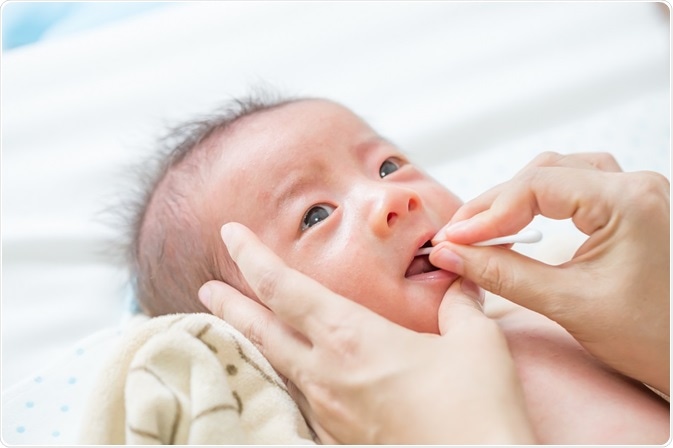Also known as dental lamina cysts or alveolar cysts, gingival cysts may occur in newborns and originate from the vestiges of dental lamina that has degenerated. These remnants give rise to the gingival cysts and are lined by epithelium, which is capable of producing keratin.

Credit: Narong Jongsirikul/ Shutterstock.com
Usually, there is disintegration of the dental lamina during a tooth’s bell stage into discrete clusters of epithelial cells. These so-called islands of cells are supposed to be reabsorbed following degeneration without any further events. However, they may in some cases persist in the gingiva and jaw.
In most cases, these small cysts undergo degeneration and subsequent involution, or they may simply just rupture into the oral cavity. Either of these occurrences may take place most often within the infant’s first 5 months of extra-uterine life. The ability of these cysts to spontaneously resolve, in addition to their fairly asymptomatic nature without discomfort to the infant, allows for them to go unnoticed.
They may, however, be observed as little white bulges on the ridge of the alveolar bone. Moreover, they may sometimes even be misdiagnosed as natal teeth owing to their deceptive appearance when clinically large enough.
The nature of gingival cysts
Gingival cysts may manifest in varying numbers, ranging from just a solitary to multiple nodules. The latter is often the case. In terms of their dimension, cysts are on average 2-3 millimeters in diameter. They can be oval or round in shape and yellowish to white in color. As many as five out of every 10 infants will develop these cysts and there is no predilection for girls or boys. Owing to the fairly transient nature of these cysts, parents rarely take their infants to be examined by a pediatrician, because they often go unnoticed.
Management and prognosis
Diagnosis of gingival cysts can be made clinically and it is very important in order to circumvent unnecessary medical interventions. One very important differential diagnosis to rule out is the presence of natal teeth. Although uncommon, natal teeth are the presence of dentition at birth, which are in contrast to neonatal teeth, which form in the first month after birth. These teeth do not have a proper root structure, are very loose and can cause injury to both infant and mother during nursing. Due to the danger of the teeth being swallowed and obstructing the airway, these teeth are often removed just after the child is born.
In treating gingival cysts, an important parameter is to reassure the parents and/or guardians that the lesions are completely benign and nothing to worry about. This is because they do not cause the baby any pain and they will spontaneously disappear. This is the key reason as to why a resounding majority in the medical literature agrees that no treatment is necessary.
References:
- https://www.ncbi.nlm.nih.gov/pubmed/7748853
- https://www.aapd.org/
- https://www.ncbi.nlm.nih.gov/pmc/articles/PMC2219100/pdf/canfamphys00172-0171.pdf
Further Reading